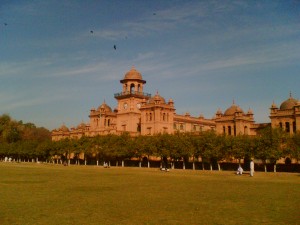Sights and Sounds of Pakistan: Peshawar Part-1
Thursday, April 26th, 2012 10:21:29 by Naveed A Bari
Sights and Sounds of Pakistan: Peshawar Part-1
Peshawar – the capital of Khyber Pakhtonkhawa is not new to the historians and tourists. It is an old – rather so old that its origins are lost in antiquity. Some believe that it was founded over 2,000 years ago by the Kushan Kings of Gandhara.
Alexander’s legions were held up here in 327 B.C. for forty days at a fort excavated recently, some 30 kilometres north-east of Peshawar at Pushkalavati (lotus city) near Charsada.
Peshawar then declined into an obscurity not broken until the 16th century. Mughal emperor Babar came to Peshawar, he found a city called Begam and rebuilt the fort there, in 1530. His grandson, Akbar, formally gave the name Peshawar which means "The Place
at the Frontier". Historians also derive Peshawar from a Sanskrit word "Pushpapura", meaning the city of flowers, or even the "City of Grain".
In the days of the Kushan King it was called the "Lotus Land". Peshawar was once the centre of Buddhist Gandhara civilization but as Buddhism declined, Peshawar also fell away from timeline. When Marco Polo visited Peshawar in about 1275 AD, he attributed
its people as "having peculiar language, who worship idols and have an evil disposition".
May be for an outsider the locals displayed an inhospitable attitude since they had been subjected to so many invasions in the past – but today anyone who visits Peshawar knows Pathans to be just the opposite – warm hearted, extremely hospitable and friendly.
After the Kushan era, Peshawar declined into an obscurity not broken until the 16th century, following the Mughal emperor Babar’s decision to rebuild the fort here in 1530. Sher Shah Suri, has successor, turned Peshawar’s renaissance into a boom when he
ran his Delhi-to-Kabul Shahi Road through the Khyber Pass.
The Mughal turned Peshawar into a ‘city of flowers’ by planting lot of shady trees and building gardens. In 1818, the Sikh ruler Ranjit Singh captured Peshawar and like what he did in Lahore and Multan, burnt a large part of the city and felled the trees
shading its many gardens for firewood.
In the ensuing 30 years of Sikh rule, Peshawar saw the destruction of Shalimar Gardens and of Baba’s magnificent fort, not to mention the dwindling of the city’s population by almost half. In 1849, came the British but were hated as much as were the Sikhs
and thus commenced a long drawn continuous warfare between the British and the Pathans, due to which a number of garrisons and forts sprang up.
To be continued…
Tags: Chilas, Kaghan, Mirnshah, Naran, Pakistan Children of the TalibanShort URL: https://www.newspakistan.pk/?p=20318

















